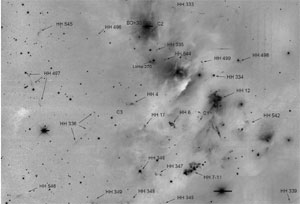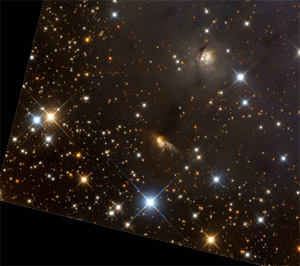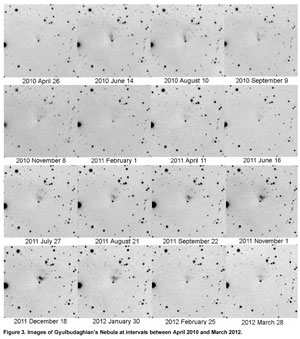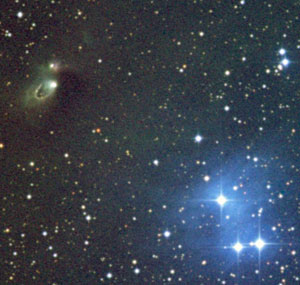
V633 Cas and V376 Cas
00 11 25.97 +58 49 29.1 Cas V633 Cas V376 Cas
The bright bluish reflection nebula in the POSS image is VdB 1 in Cassiopeia, which is obvious and appears somewhat structured. On the left side, V633 Cassiopeiae (PP2) appears stellar within a diffuse halo that is extended toward SE. The ring structure could not be seen. V376 Cassiopeiae (PP3) is much more difficult and could be seen intermittently with averted vision with 350x. Associated with these two objects are Herbig-Haro objects HH161/162/164, which are, however, not to be confused with the reflection nebula visible in the image to the left.
NGC 1333 in Perseus
03 29 02 +31 20 54 Per NGC1333
At 350x, the region of NGC 1333 in Perseus can be decomposed into several regions. A northern RN around the bright star. In the middle part a large RN that is divided by a dark rift. SW of it is an extremely faint diffuse object (HH12). S of it is another extremely faint patch with several Herbig-Haro Objects (HH7-11).
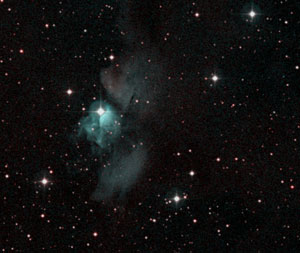
XY Persei
03 49 37.03 +38 58 57.6 Per XY Per
At 200x, the VdB 24 RN of XY Persei is quite obvious around the star, extending in particular toward SW. No crescent shape could be discerned. The RN is terminated toward NW by a distinct dark band. Northern edge of band appeared defined, therefore additional nebulosity N of it is suspected.
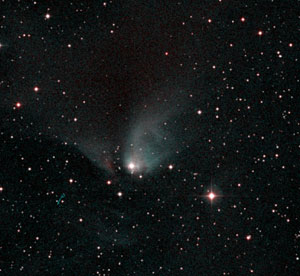
RY Tauri
04 21 56.75 +28 26 33.9 Tau RY Tau
At 200x, RY Tauri has a distinct reflection nebula (vdB 27) that is fan-shaped extending from star to NW. The edge of the nebula is sharply defined toward S and E.
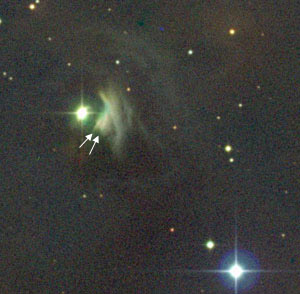
T Tauri and Hind's Variable Nebula, NGC 1555
04 22 00.00 +19 36 00.0 Tau T Tauri
Hind's Variable Nebula, NGC 1555, around the T Tauri prototype. With indirect vision, it is crescent shaped and W of T Tauri, winding around the star. The S end of the RN appears clearly divided. This is probably the structure marked with an arrow.
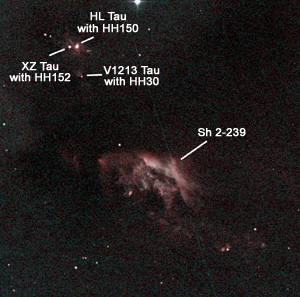
Sharpless 239 in Taurus
04 31 16.80 +18 07 12.0 Tau Sh2-239
At 100x, the few field stars outside Sharpless 239 in Taurus can be held steadily. With field sweeping and without filter, the nebula can be seen as a very weak, extended glow without internal structure, size and position matching the DSS print.
NE of Sh2-239, in the same molecular cloud are other YSOs, with HL and XZ Tauri being the brightest of them.
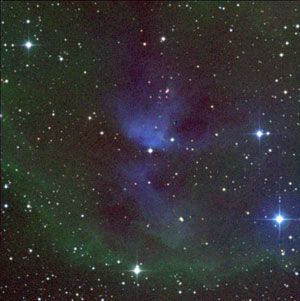
HK Orionis
05 31 28.05 +12 09 10.2 Ori HK Ori
With 200x, HK Orionis is easily seen as a relatively bright star. The reflection nebula Ced 51 was observed w/o filter as a faint brightening NW of the star, extending somewhat in the direction of the nearby weaker star. The RN could be observed also with UHC filter, though the filter did not increase its visibility.
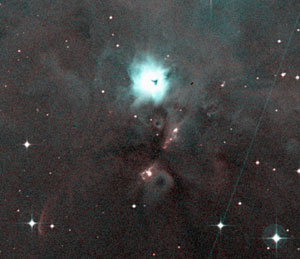
The Keyhole Nebula, NGC 1999, around V380 Orions
05 36 27 -06 43 18 Ori V380 Ori
NGC 1999 in Orion is an easy object already in smaller telescopes. The nebulosity is small. The star V380 Ori sits within the nebulosity at the edge of the keyhole shaped hole (which according to IR imaging with the Herschel Space Telescope is indeed a hole and not a dark Bok globule) to the W. HH1 and HH2 are to the S of NGC 1999. HH2 could be seen directly, while HH1 was an averted vision object.
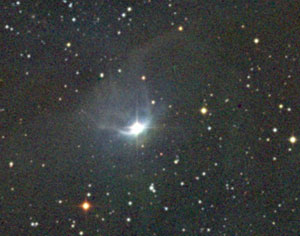
FU Orionis
05 45 22.4 +09 04 11 Ori FU Ori
FU Orionis is a relatively bright star surrounded by the reflection nebula Ced 59. With 500x, an extremely faint nebulosity was detected surrounding the star, extending somewhat more towards SW. This is the prototype of the FUOr flare stars.
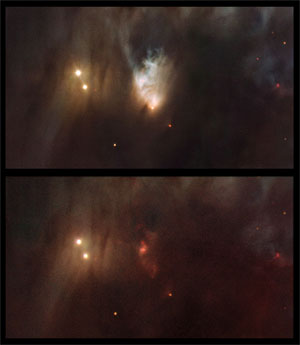
ESO/T. A. Rector/University of Alaska Anchorage, H. Schweiker/WIYN and NOAO/AURA/NSF and Igor Chekalin
McNeils' Nebula around V1647 Orionis
05h 47 + 04 45 Ori V1647 Ori
Maybe you remember the sudden appearance of McNeil's Nebula in M78? This nebula was discovered photographically as a new object in the dusty landscape around M78 in 2004 by amateur observer Jay McNeil. At that time, it was accessible to visual observation. An attempt to observe the nebula in 2006 with my 22" Dob failed. In the end of 2008 it appeared to brighten again and I gave it another try.
It proved to be not exactly easy to locate the field. Due to the obscuring
dark clouds, the environment of M78 lacks stars and star patterns suitable
for star hopping, and the few remaining stars are considerably dimmed. It
took me therefore some time to locate the precise position and to
permanently hold the faint field stars. Close to the position of McNeil's
Nebula is a close pair of stars, which are difficult to split visually due
to their faintness. This double star forms an equilateral triangle with two
other stars to the south and to the west. Mc Neil's nebula is next to the
double star. I estimated the nebula's brightness to be somewhat lower than
that of the combined double star, but it could be seen steadily with averted
vision.
There are further YSOs toward S (not observed).
Re-observed in January 2011 with similar result. Towards the end of 2011, the nebula appears to have dimmed again and was not visible anymore (considerably dimmer than the two neighboring stars).
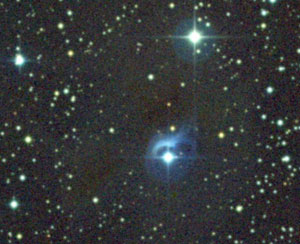
V1307 Orionis
06 01 59.99 +16 30 56.7 Ori V1307 Ori
V1307 Orionis is a bright star with other bright stars in the same field. With 350x, a very faint elongated nebulosity was detected at the N side of the star. The nebulosity was better defined on its N side and relatively large. Quite similar to Hind's Variable Nebula.

Cederblad 62 in Orion
06 07 49.49 +18 39 27.0 Ori Ced 62
Ced 62 (NGC 2163) is a bright bilobal nebula around HBC 193 at the border Orion/Gemini that is visible already in medium sized telescopes. Not precisely like an hourglas, the nebulosity is not fully constricted at the position of the star. W side is better defined. N fan is brighter and larger with a brighter streak at its W border. S fan is weaker and appears a bit separated from the star.
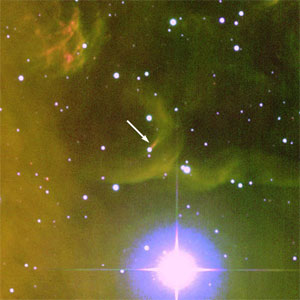
Rosette HH1 in Monoceros
06 32 20.79 +04 52 58.2 Mon Rosette HH1
The Rosette HH1 results from outflow of a T Tauri star creating a jet. Under poor observing conditions the T Tauri star was steadily visible, but appeared only stellar.
Image: T. Rector/University of Alaska Anchorage, WIYN and NOAO/AURA/NSF
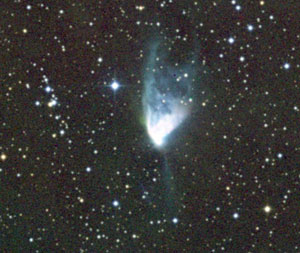
Hubble's Variable Nebula, NGC 2261, around R Monocerotis
06 39 09.51 +08 44 39.6 Mon R Mon
With 350x, Hubble's Variable Nebula around R Monocerotis is very bright and quite evenly illuminated. It appears fan shaped, extending to the NE from the star, which is somewhat offset from the tip of the nebula. The fan is curved to the W, with its W side being longer than its E side.
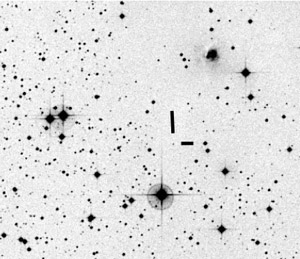
DSS
Adam Block/Mount Lemmon SkyCenter/University of Arizona, 2011
Thommes' Nebula around V900 Monocerotis
06 57 22 -08 23 22 Mon V900 Mon
Thommes' Nebula is a YSO discoverd by Jim Thommes in 2009 around the FUor V900 Mon.
At the eyepiece, this is a relatively easy YSO, appearing as clearly non-stellar direct vision object. At times, it appeared elongated with a tail-like feature pointing towards southern direction, possibly reflecting outflow.

HBC 547 / NGC 2316 / Parsamian 18 in Monoceros
06 59 41.56 -07 46 28.8 Mon HBC 547
At 350x, HBC 547 is surrounded by a quite distinct nebula of round shape. There are two possibly stellar condensations within the nebula.
NGC 2316 is the embedding star cluster.
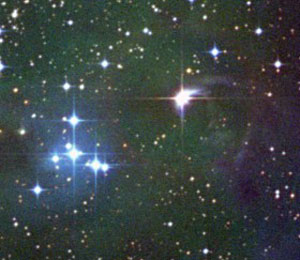
Z Canis Majoris
07 03 43.16 -11 33 06.2 CMa Z CMa
At 500x, the FU Ori star Z Canis Majoris is quite bright. In 2017, the nebula is quite distinctly visible as a very elongated streak extending towards N and curving W. Another stubbier and less distinct extension is visible towards S. In 2011, the nebula was much more difficult.
This is one of the few YSOs where substantial variability can be detected on relatively short time scales.
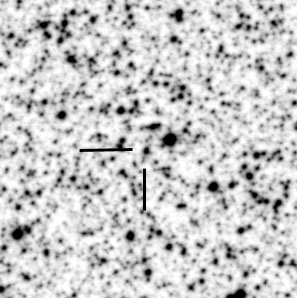
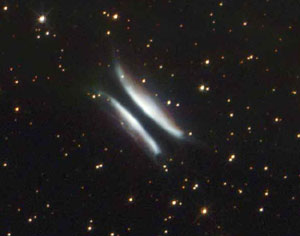
Gomez's Hamburger in Sagittarius
18 09 13 -32 10 48 Sag IRAS 18059-3211
Gomez's Hamburger in Sagittarius was initially classified a proto-PN, but this is being debated. Recent papers classify this object as a YSO with protoplanetary disk (ironically, the term "protoplanetary" has two very different meanings in both object classes!).
I observed the Hamburger during a night with excellent transparency down to the horizon. The YSO could be seen several times with indirect vision as an extremely faint stellar object.
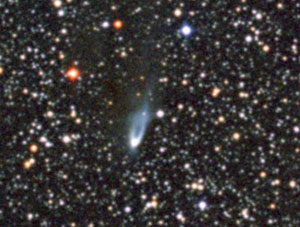
Parsamian 21 in Aquila
19 29 01 +09 38 43 Aql Parsamian 21
Parsamian 21 in Aquila is a very nice cometary nebula. It is relatively bright and immediately visible. It is elongated, extending from a bright knot (star?). According to the literature, it's light should be partially polarized. I could not detect any polarization using a linear polarizer.
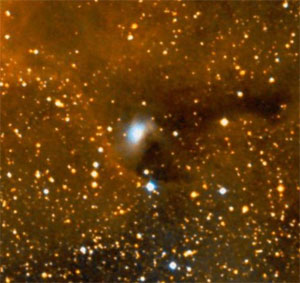
GM 2-39 in Cygnus
20 17 08.05 +38 59 29.4 Cyg GM 2-39
GM 2-39 in Cygnus (from the catalog by Gyulbudaghian & Maghakian) is a very small, but quite distinct and pretty nebula next to a prominent curved star chain. The small YSO appears at 350x as a very diffuse object that becomes very much brighter to the center. The core appears stellar and I suspected it after some time to be elongated somewhat in NS direction.
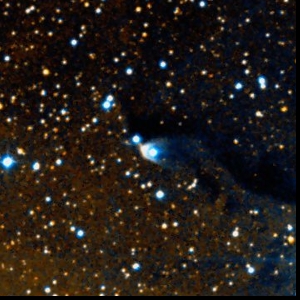
GM 1-27 / GN 20.18.3 in Cygnus
20 20 12.7 +37 10 09 Cyg GM 1-27
I observed GM 1-27 (GN 20.18.3 in the Atlas Galaktischer Nebel) several times. The star superimposed on the RN appeared brighter than neighboring star NE. Nebulosity suspected.
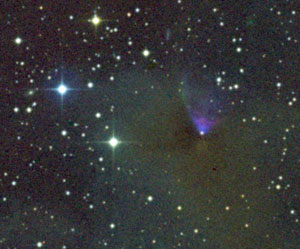
Boyd, 2012SASS...31...65B, click on image for larger scale
Gyulbudaghian's Nebula, GM 1-29, around PV Cephei
20 45 54 67 57 51 Cep PV Cep
PV Cephei and its associated RN, Gyulbudaghian's Nebula, are highly variable. While they used to be accessible even to smaller telescopes during the last outburst in 2004, they were during their quiet phase in the following years very difficult even for large telescopes.
09/2008: nothing visible, neither nebula nor star PV Cep
07/2010: dito
08/2010: star suspected a few times, doubtful
10/2010: intermittently an extremely faint and somewhat extended object was observed at the location with indirect vision
10/2011: extremely faint, rather stellar object visible. This observation could as well have been a small bright knot in the nebula, as suggested by the set of images on the lower left side.
08/2012: Nothing :-(
Outburst 2013-2016
08/2013: The nebula has considerably brightened and is now visible as a relatively bright fan-shaped glow, even with direct vision. PV Cep, the star, could not be discerned. Was observed by others with apertures down to 12"
09/2013 bright, fan shaped, direct vision
10/2014 much fainter, only a structureless glow with averted vision
11/2015 nebula is immediately visible, but fainter than in 2013, it appears with indirect vision fan shaped with an angle of approximately 60°, PV Cep is visible indirectly as a very faint stellar point
10/2016 nebula is fairly bright, PV Cep is permanently visible
10/2017 end of the outburst, neither star nor nebula are visible :-(
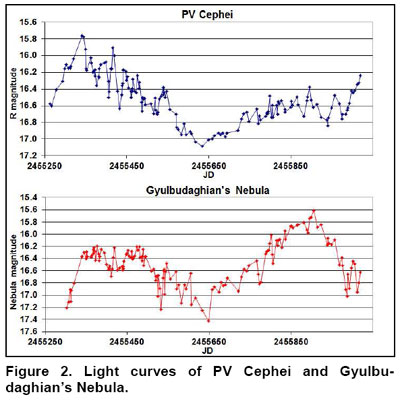
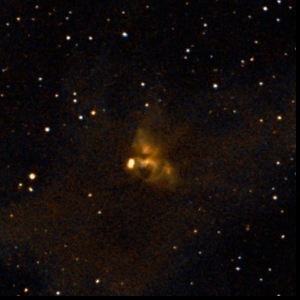
RNO 129 in Cepheus
20 59 14.09 +78 23 04.0 Cep RNO 129
Observed with 200x and (better) with 350x. RNO 129 with the reflection nebula GN 21.00.4 is positioned between two stars, A and B. A is bright, B is dimmer and consists of several stars. Both are directly visible. Between both, closer to B is a diffuse, non-stellar something, which can be seen with indirect vision about 50% of the time. I cannot make out any details. Looks quite similar to one of those very faint Hickson groups. .
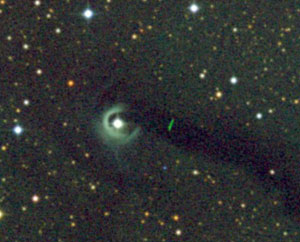
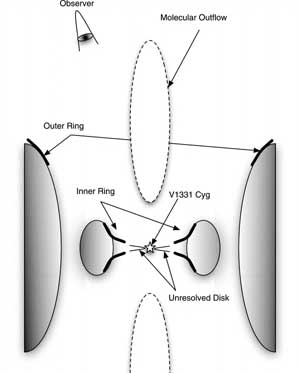
V1331 Cygni
21 01 09.21 +50 21 44.8 Cyg V1331 Cyg
V1331 Cygni is a very interesting object on the DSS image. But while the star itself is bright and easy, the ring is exceedingly difficult. At times, an extremely faint "envelope" was suspected around the star, at least on one side.
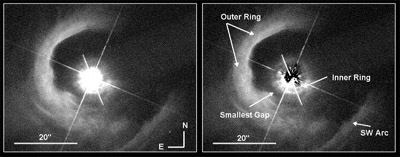
image credit (above and left): Quanz et al., ApJ (2007) 256:287
This HST image shows the environment of V1331 Cyg with the star (left) and with the star subtracted (right), revealing an additional inner ring.

G98-171 around V1982 Cygni
21 03 55.92 +50 14 24.0 Cyg V1982 Cygni
Gyulbudaghian 98-171 around V1982 Cygni is a relatively bright object. At 350x, the nebula is immediately visible, extending E of V1982. It appears at times as a fairly defined streak with another stellar object at its eastern tip, which is HBC 727.
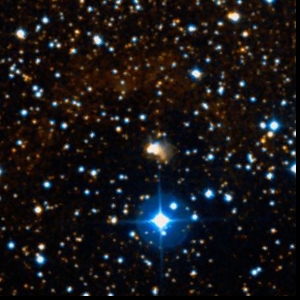
V645 Cygni (Duck Nebula)
21 39 58.24 +50 14 21.2 Cyg V 645 Cyg
At 350x, V645 Cygni appears directly as a stellar object visible with direct vision. Indirectly, a distinct small cometary tail appears that is oriented to the W. Comparatively easy target.
Contains HH118.
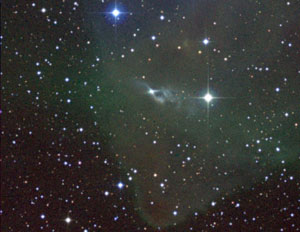
V375 Lacertae
22 34 41.04 +40 40 03.6 Lac V 375 Lac
V375 Lacertae appears as a weak stellar object. Extremely faint extension to SW were only suspected. The embedding nebulosity is Sharpless 126.
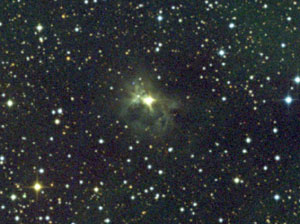
V628 Cassiopeiae
23 17 25.57 +60 50 43.3 Cas V628 Cas
With 7 mm, V628 Cassiopeiae appears bright and stellar with direct vision. With indirect vision, I suspected an extended glow to the E.
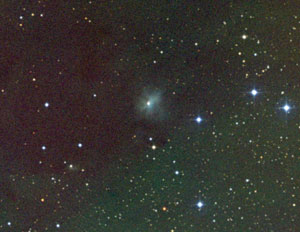
LKHa 259 in Cepheus
23 58 41.54 +66 26 12.9 Cep LkHa 259
With LKHa 259 in Cepheus, a faint glow could be seen relatively easily, which is condensed to the middle with a stellar center. Sometimes, the nebula appeared fan shaped, with the broader side opening to NW.
